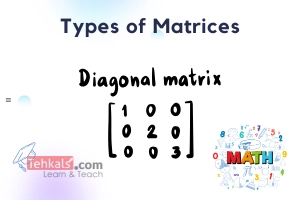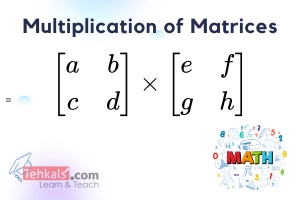Addition of Matrices
Published: 11 Mar 2023
In this blog post, you will find how to add and subtract matrices step by step with examples and MCQs to help you to understand the concept. Whether you are new to matrices or need a refresher, this post is perfect.
After covering this, you will be able to learn about the basic concepts related to Addition, Subtraction of matrices and other related ideas related to Addition of Matrices.
Addition of Matrices – Definition and Concept
To understand matrix addition, it’s essential to know the concept of matrices. A matrix is defined by its order, represented by the number of rows and columns.
When two matrices have the same order, the addition of matrices is possible. Two matrices have the same order means “the same number of Rows and Columns.”
If the order of the matrix is different, addition cannot be possible.
Subtraction of Matrices – Concept
When two matrices have the same order, the subtraction of matrices is possible.
Addition of matrices explained
$ A=\left[\begin{array}{ll}3 & 8 \\4 & 6\end{array}\right], B=\left[\begin{array}{cc}4 & 0 \\1 & -9\end{array}\right] \\$
$ C=\left[\begin{array}{ccc} -3 & 4 & -5 \\ 2 & 3 & 1 \end{array}\right] $
$ D=\left[\begin{array}{ccc} -3 & -4 & 5 \\ 1 & 2 & 3 \end{array}\right] \\ $
1. $ A+B $
As the order of A is $ 2-by-2 $
And the order of B is $ 2-by-2 $
Hence orders are same
So $ A+B $ is possible.
2. $ B+D $
As the order of B is $ 2-by-2 $
And the order of D is $ 2-by-3 $
So $ B+D $ is not possible.
3. $ A-C $
As the order of A is $ 2-by-2 $
And the order of C is $ 2-by-3 $
So $ A-C $ is not possible.
4. $ C-D $
As the order of C is $ 2-by-3 $
And the order of D is $ 2-by-3 $
So $ C-D $ is possible.
Addition of matrices
$ A=\left[\begin{array}{ll}3 & 8 \\4 & 6\end{array}\right], B=\left[\begin{array}{cc}4 & 0 \\1 & -9\end{array}\right] \\ $
step : 1 Ensure that both matrices have the same dimensions.
Both matrices A and B have same dimensions $ 2 \times 2. $
step : 2 Write down the matrices.
$ A+B=\left[\begin{array}{ll}3 & 8 \\4 & 6\end{array}\right]+\left[\begin{array}{cc}4 & 0 \\1 & -9\end{array}\right] \\ $
step : 3 Add the corresponding elements of the matrices and simplify.
$ A+B=\left[\begin{array}{ll}3+4 & 8+0 \\4+1 & 6-9\end{array}\right] \\ $
$ A+B=\left[\begin{array}{cc}7 & 8 \\5 & -3\end{array}\right] \\ $
Subtraction of matrices
Example:
$ A=\left[\begin{array}{ll}3 & 8 \\4 & 6\end{array}\right], B=\left[\begin{array}{cc}4 & 0 \\1 & -9\end{array}\right] \\ $
$ A-B $
$ =\left[\begin{array}{ll}3 & 8 \\4 & 6\end{array}\right]-\left[\begin{array}{cc}4 & 0 \\1 & -9\end{array}\right] \\ $
$ A-B=\left[\begin{array}{ll}3-4 & 8-0 \\4-1 & 6+9\end{array}\right] \\ $
$ A-B=\left[\begin{array}{cc}-1 & 8 \\3 & 15\end{array}\right] \\ $
Commutative Property of matrix w.r.t Addition
$ C=\left[\begin{array}{ccc} -3 & 4 & -5 \\ 2 & 3 & 1 \end{array}\right] $
$ D=\left[\begin{array}{ccc} -3 & -4 & 5 \\ 1 & 2 & 3 \end{array}\right] \\ $
$ {C}+{D}={D}+ {C} \\ $
LHS:
$ C+D $
$ =\left[\begin{array}{ccc} -3 & 4 & -5 \\ 2 & 3 & 1 \end{array}\right]+\left[\begin{array}{ccc} -3 & -4 & 5 \\ 1 & 2 & 3 \end{array}\right] \\ $
$ =\left[\begin{array}{ccc} -3-3 & 4-4 & -5+5 \\ 2+1 & 3+2 & 1+3 \end{array}\right] \\ $
$ =\left[\begin{array}{ccc} -6 & 0 & 0 \\ 3 & 5 & 4 \end{array}\right] $
RHS
$ D+C $
$ =\left[\begin{array}{ccc}-3 & -4 & 5 \\ 1 & 2 & 3\end{array}\right]+\left[\begin{array}{ccc}-3 & 4 & -5 \\ 2 & 3 & 1\end{array}\right] $
$ =\left[\begin{array}{ccc}-3-3 & -4+4 & 5-5 \\ 1+2 & 2+3 & 3+1\end{array}\right] $
$ =\left[\begin{array}{ccc}-6 & 0 & 0 \\ 3 & 5 & 4\end{array}\right] $
Associative Property of Matrix w.r.t Addition
$ A+(B+C)=(A+B)+C $ is called the Associative law under addition.
Verify
$ {A}+({B}+{C})=({A}+{B})+{C} $
for the following matrices.
$ A=\left[\begin{array}{cc}2 & -3 \\ 4 & 1\end{array}\right], $
$ B=\left[\begin{array}{cc}5 & -2 \\ 3 & 6\end{array}\right], $
$ C=\left[\begin{array}{cc}1 & 7 \\ -6 & -3\end{array}\right] $
Solution:
$ {A}+({B}+{C})=({A}+{B})+{C} $
LHS: $ A+(B+C) $
$ B+C $
$ =\left[\begin{array}{cc}5 & -2 \\ 3 & 6\end{array}\right]+\left[\begin{array}{cc}1 & 7 \\ -6 & -3\end{array}\right] $
$ =\left[\begin{array}{cc}5+1 & -2+7 \\ 3-6 & 6-3\end{array}\right] $
$ =\left[\begin{array}{cc}6 & 5 \\ -3 & 3\end{array}\right] $
$ A+(B+C) $
$ =\left[\begin{array}{cc}2 & -3 \\ 4 & 1\end{array}\right]+\left[\begin{array}{cc}6 & 5 \\ -3 & 3\end{array}\right] $
$ =\left[\begin{array}{cc}2+6 & -3+5 \\ 4-3 & 1+3\end{array}\right] $
$ =\left[\begin{array}{ll}8 & 2 \\ 1 & 4\end{array}\right] $
RHS: $ (A+B)+C $
$ A+B $
$ =\left[\begin{array}{cc}2 & -3 \\ 4 & 1\end{array}\right]+\left[\begin{array}{cc}5 & -2 \\ 3 & 6\end{array}\right] $
$ =\left[\begin{array}{cc}2+5 & -3-2 \\ 4+3 & 1+6\end{array}\right] $
$ =\left[\begin{array}{cc}7 & -5 \\ 7 & 7\end{array}\right] $
$ (A+B)+C $
$ =\left[\begin{array}{cc}7 & -5 \\ 7 & 7\end{array}\right]+\left[\begin{array}{cc}1 & 7 \\ -6 & -3\end{array}\right]$
$ =\left[\begin{array}{cc}7+1 & -5+7 \\ 7-6 & 7-3\end{array}\right] $
$ =\left[\begin{array}{ll}8 & 2 \\ 1 & 4\end{array}\right] $
Hence
$ A+(B+C)=(A+B)+C $
Proved
MCQs on matrix addition
To test your knowledge of matrix addition, here are a few multiple-choice questions:
1. Two matrices are conformable for addition/subtraction, if they are of the ________ order.O Row
O Column
O Same
O Different
Show Answer
Same
Explanation:
When the number of rows and columns of both the matrices are same, then both the matrices can be added/subtracted.
2. Addition of two matrices is obtained by adding the ________ elements of the matrices.
O Row
O Column
O Corresponding
O Different
Show Answer
Corresponding
Explanation:
For Addition of matrices, it must be noted to add the corresponding elements.
3. The addition of $ A=\left[\begin{array}{lll}1 & -2 & 3\end{array}\right] \ and \ B=\left[\begin{array}{lll}a & b & c\end{array}\right] $ is ________.
O Possible
O Not possible
O Identity matrix
O None of these
Show Answer
Possible
Explanation:
The addition of Matrix A and B is possible, because the order of both the matrices are same, that is:
$ 1-by-3 $
4. The addition of $ A=\left[\begin{array}{lll}1 & 2 \end{array}\right] \ and \ B=\left[\begin{array}{lll}a & b & c\end{array}\right] $ is ________
O Possible
O Not possible
O Identity matrix
O None of these
Show Answer
Not possible
Explanation:
The addition of Matrix A and B is not possible, because the order of both the matrices are not same.
5. The real number is multiplying to ________ elements of the matrix.
O Each
O Row
O Column
O All of these
Show Answer
Explanation:
The real number is multiplied to each elements of the matrix. Example is in MCQs No. 6
6. If $ A=\left[\begin{array}{lll}1 & -2 & 3\end{array}\right] \ then \ -3A= $ ________
O $ \left[\begin{array}{lll}-3 & -2 & -9\end{array}\right] $
O $ \left[\begin{array}{lll}-1 & 2 & 3\end{array}\right] $
O $ \left[\begin{array}{lll}-3 & 6 & -9\end{array}\right] $
O None of the above
Show Answer
$ \left[\begin{array}{lll}-3 & 6 & -9\end{array}\right] $
Explanation:
$ A=\left[\begin{array}{lll}1 & -2 & 3\end{array}\right]$
$ -3A=-3\left[\begin{array}{lll}1 & -2 & 3\end{array}\right]$
$ -3A=\left[\begin{array}{lll}-3 & 6 & -9\end{array}\right]$
7. $ A+B=B+A $ is ________ property under addition.
O Commutative
O Associative
O Distributive
O None of these
Show Answer
Commutative
8. $ A+(B+C)=(A+B)+C $ is ________ law under addition.
O Commutative
O Associative
O Distributive
O None of these
Show Answer
Associative
9. $ A+0 \ or \ 0+A = $ ________
O B
O A
O 0
O All of these
Show Answer
A
Explanation:
When zero (0) is added to any number, the answer should be that mumber.
$ 0+3=3 $
10. $ \left[\begin{array}{lll}0 & 0 & 0 \\ 0 & 0 & 0\end{array}\right] $ is ________ matrix.
O Additive identity
O Zero
O Null
O All of these
Show Answer
All of these
11. The ________ matrix is the additive identity for addition.
O Identity
O Scalar
O Null
O None of these
Show Answer
Null
Explanation:
When a null matrix is added to any matrix, the result is that matrix which shows the additive identity.
12. The null matrix is the additive ________ for addition.
O Identity
O Scalar
O Null
O None of these
Show Answer
Identity
Explanation:
When a null matrix is added to any matrix, the result is that matrix which shows the additive identity.
13. The additive identity of $ \left[\begin{array}{ll}1 & 3 \\ 2 & 4\end{array}\right] $ is ________
O $ \left[\begin{array}{ll}0 & 0 \\ 0 & 0\end{array}\right] $
O $ \left[\begin{array}{ll}1 & 3 \\ 2 & 4\end{array}\right] $
O $ \left[\begin{array}{ll}1 & 2 \\ 3 & 4\end{array}\right] $
O $ \left[\begin{array}{ll}-1 & -3 \\ -2 & -4\end{array}\right] $
Show Answer
$ \left[\begin{array}{ll}0 & 0 \\ 0 & 0\end{array}\right] $
Explanation:
Zero is the additive identity.
14. The additive identity of $ \left[\begin{array}{ll}1 & 3 \\ 2 & 4\end{array}\right] $ is ________
O $ {\left[\begin{array}{ll}0 \end{array}\right] } $
O $ {\left[\begin{array}{ll}0 & 0 \\ 0 & 0\end{array}\right] } $
O $ {\left[\begin{array}{ll}1 & 3 \\ 2 & 4\end{array}\right] } $
O $ \left[\begin{array}{ll}-1 & -3 \\ -2 & -4\end{array}\right] $
Show Answer
$ {\left[\begin{array}{ll}0 & 0 \\ 0 & 0\end{array}\right] } $
Explanation:
The order of null matrix is same of that matrix.
15. In additive inverse, the sum of two matrices are ________
O Identity
O Zero
O a & b
O None of these
Show Answer
Zero
16. If $ A+B=0 $ then B is the _______ inverse of A
O Multiplicative
O Additive
O Zero
O None of these
Show Answer
Additive
Explanation:
When the sum of two numbers is zero, then they are the additive inverse of each other.
17. If $ P+Q=0 , then P \ and \ Q $ are the ________ inverse of each other.
O Additive
O Multiplicative
O Identity
O All of these
Show Answer
Additive
Explanation:
When the sum of two numbers is zero, then they are the additive inverse of each other.
18. The additive inverse of $ \left[\begin{array}{ll}1 & -3 \\ 2 & 4\end{array}\right] $ is ________
O $ \left[\begin{array}{ll}0 & 0 \\ 0 & 0\end{array}\right] $
O $ \left[\begin{array}{ll}1 & 3 \\ 2 & 4\end{array}\right] $
O $ \left[\begin{array}{ll}1 & 2 \\ 3 & 4\end{array}\right] $
O $ \left[\begin{array}{ll}-1 & 3 \\ -2 & -4\end{array}\right] $
Show Answer
$ \left[\begin{array}{ll}-1 & 3 \\ -2 & -4\end{array}\right] $
Explanation:
when the sum of two matrices is zero OR the matrices of opposite signs.
$ \left[\begin{array}{ll}1 & -3 \\ 2 & 4\end{array}\right]+\left[\begin{array}{ll}-1 & 3 \\ -2 & -4\end{array}\right] =\left[\begin{array}{ll}0 & 0 \\ 0 & 0\end{array}\right] $
- Be Respectful
- Stay Relevant
- Stay Positive
- True Feedback
- Encourage Discussion
- Avoid Spamming
- No Fake News
- Don't Copy-Paste
- No Personal Attacks
- Be Respectful
- Stay Relevant
- Stay Positive
- True Feedback
- Encourage Discussion
- Avoid Spamming
- No Fake News
- Don't Copy-Paste
- No Personal Attacks


